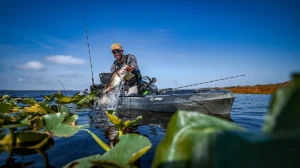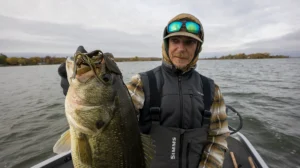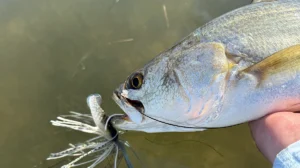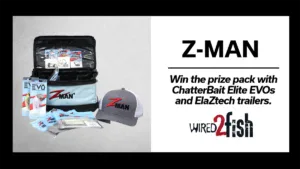The punching technique and associated punch rig came about from the need to penetrate soft plastics through matted vegetation. California Delta-based pro bass angler Nick Smith discusses the benefits of using a Tokyo Rig over a traditional punching setup when hunting bass hiding underneath thick mats of vegetation.
TACKLE USED (retail links)
- TOKYO RIG – VMC Tokyo Rig, 3/0
- TOKYO RIG (long dropper) – VMC Tokyo Rig Heavy Duty Wide Gap XLS
- PLASTIC – Savage Gear Dragontail, 6-inch
- WEIGHT – VMC Tungsten Flippin Weights, 3/4-ounce (opposing orientation)
- ROD – Stix Fishing #6 Power Stik Casting Rod
- REEL – Daiwa Fuego CT Casting Reel
- LINE – P-Line TCB 8 Teflon Coated Braid
The punch shot rig, and manufactured Tokyo Rig, is an innovative offshoot that hangs the weight off an independent dropper wire, dragging the unweighted hook and plastic through the mat and to the bottom. While not always the best approach, the Tokyo Rig offers some advantages when punching mats. Smith outlines these benefits and general pointers to improve your punching game.
-
Fishes clean
It’s not uncommon for a traditional punch rig to get gummed up with grass and other organics, whereas the free-swinging dropper wire of the Tokyo Rig does an excellent job at cutting and tearing grass. This “weed wacker” effect clears certain (not all) grass types from the presentation, resulting in more high-percentage casts.
-
Plastic stays exposed
Most punch rigs are fished mid-water column or just under the mat, but bass sometimes prefer eating off the bottom. A traditional punch rig tends to sink into the soft bottom sediment typical of thick grass beds. On the other hand, with its dropper wire construction, the Tokyo Rig keeps the bait visible and accessible to the bass on the bottom, where bass can pounce on it, and you can drive hooks home. Try the XLS Tokyo Rig, which features a longer dropper arm, when you want your bait to ride higher. Consider using a floating or more buoyant plastic to keep the bait separated from the bottom. Smith opts for the streamlined Savage Gear Dragontail, which is made from their durable and buoyant Duratech material.
-
More action
Two welded o-rings allow your hook to move independently and unimpeded by the weight. This increased freedom of movement translates into significantly more bait action than a stiff, pegged punch rig.
-
Penetrates mats more easily
An underwater analysis of the Tokyo Rig reveals a distinctly different process by which the hook and plastic sinks to the bottom. The wire dropper arm and weight punches a hole in the surface through which the trailing plastic and hook slide through. Smith also thinks it’s much easier to gain penetration without exerting much downward force or momentum.
Smith shares a few additional tips, such as why you need to focus pitches at the base of tulles before punching indistinguishable expanses of mats and how a high-vis braided line with a black end section serves as an excellent indicator of a successful pitch to the heart of the mat.


![[VIDEO] Top 5 Baits for Schooling Bass Success](https://www.wired2fish.com/wp-content/uploads/2025/12/cooper-dbs-website-300x169.webp)
![[VIDEO] Filleting Bluegill Made Easy: Tips and Tricks](https://www.wired2fish.com/wp-content/uploads/2025/05/bluegill-cleaning-300x169.webp)
![[VIDEO] Cold Front Hack for Catching Shallow Bass](https://www.wired2fish.com/wp-content/uploads/2025/12/scanlon-website-300x169.webp)
![[VIDEO] Maximize Your Graphs – Pro Tips & Tricks](https://www.wired2fish.com/wp-content/uploads/2025/12/huff-website2-300x169.webp)










